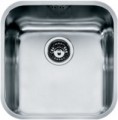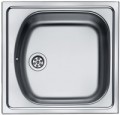Mount type
The standard way to mount the sink. Some models allow multiple ways to install, at the user’s choice. The specific options may be:
—
Mortise overhead. Models fitted in the slot of the worktop in such a way that the side of the sink is significantly above the surface of the worktop. The method of installation is quite simple, but the side raised above the table is in some cases inconvenient.
—
Mortise back to back. Models installed in the slot of the worktop so that the side of the sink is at the level of the worktop. Popular due to the ease of installation and convenience in cleaning: if necessary, water and other contaminants can be «driven» by a cloth from the table top directly to the sink. It is true that there is a small gap between the countertop and the sink where pollution can accumulate; but this disadvantage is compensated by the ease of installation.
—
Tabletop. Models fixed at the bottom of the countertop - so that the role of the sides actually play the edges of the hole cut under the sink. This method is convenient for maximum convenience in cleaning: from the kitchen table you can easily wipe into the sink spilled liquid or small debris like crumbs, while the contamination will not accumulate in the gap between the sink and the table top (As opposed to butt mounting, see corresponding paragraph. ). At the same time,
...the installation of such shells by itself is quite difficult.
— Tabletop module. Quite specific installation method: the sink is installed on the floor top, replacing the table top. For such an installation, it is necessary that the box accurately corresponds to the sink in size, so this option is quite rare.Shape
The general shape of the sink. Note that this parameter is not indicated by the shape of the bowl, but by the shape of the product as a whole (although often these moments coincide).
In addition to the classical forms (
rectangular,
square,
>>> roundnon-standard design, which can have very unusual outlines. These sinks should pay attention to those who try to decorate the kitchen in an unusual style.
Surface type
Type of washing surface made of stainless steel (cf. «Body material»).
— Glossy. Brilliant, mirror surface, distinguished by attractive appearance. On the other hand, on such a surface quickly appear contamination and mechanical damage (traces from dried water, fingerprints, scratches, etc.), so to preserve the appearance it needs to be cleaned regularly, or even polished.
— Matte. The matte surface does not look as bright as glossy - it is fainter, without pronounced reflections. On the other hand, such surfaces are less susceptible to contamination and damage: fingerprints, traces of dried water, scratches and scuffs on such surfaces are not as visible as on gloss.
— Textured. Surface having a relief pattern with a depth of a fraction of a millimeter. This material is most convenient and practical from the point of view of maintenance, it perfectly masks contamination and is well resistant to scratches. The main drawback of textured surfaces is higher cost than matt and glossy. In addition, contamination and bacteria can accumulate in grooves, so clean such sinks should be with special care.
Minimum cabinet width (base)
The smallest width of the cabinet, pedestal or other base required for the installation of the sink. By width in this case means the distance between the side walls of the cabinet (base). If the width of the sink is too small, it will not get the necessary support, and its normal use will be impossible.
Main minimum dimensions:
>less than 45 cm, 45 cm, 50 cm, 60 cm, 80 cm,
more than 80 cm.

